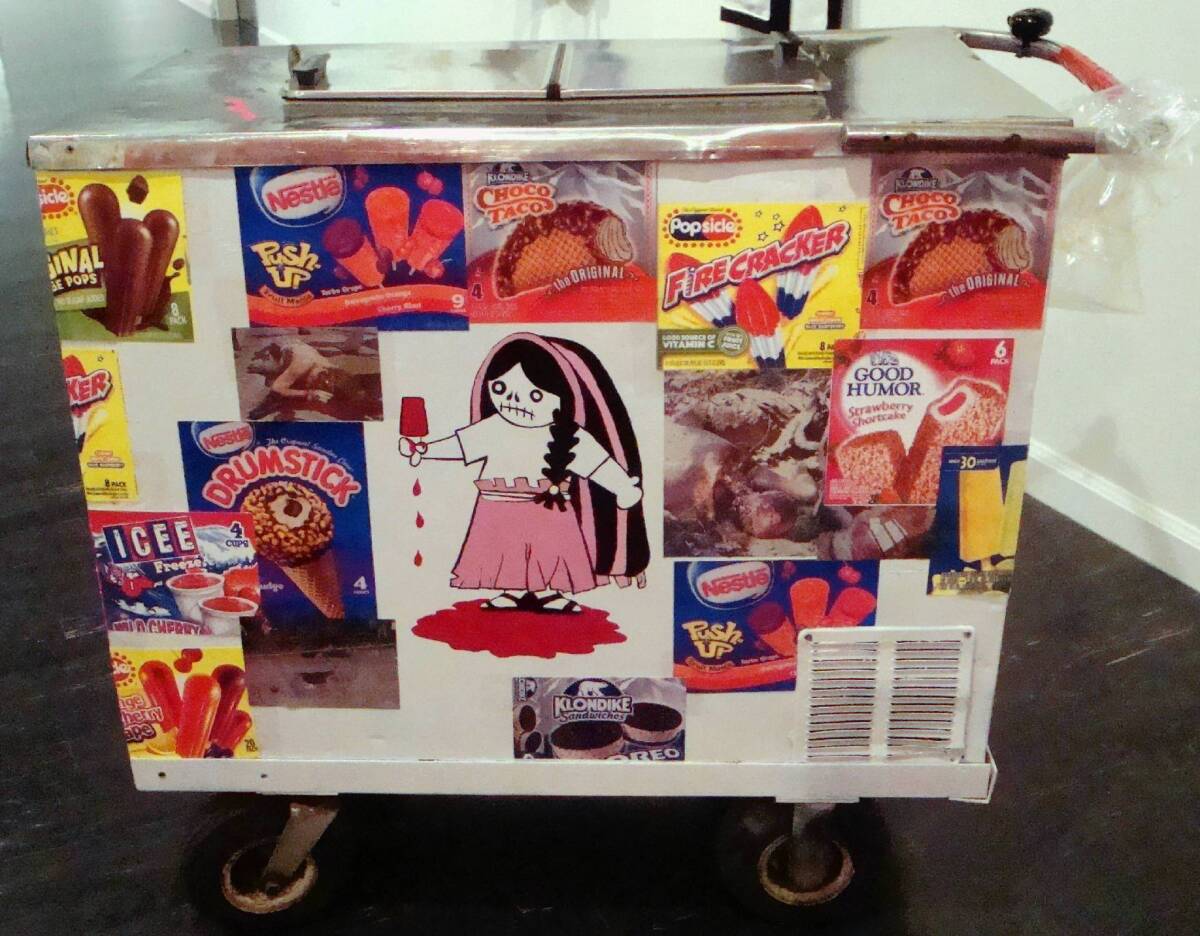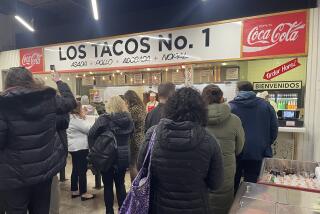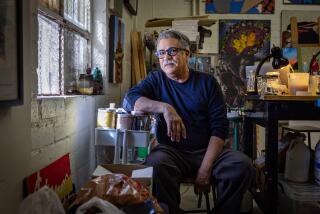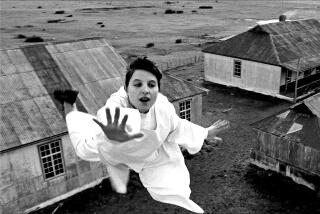Art review: At MexiCali Biennial, cannibalism is consuming theme

As an eye-catching theme for an exhibition, cannibalism surely ranks right up there.
At East Los Angeles College’s Vincent Price Art Museum, cannibalism is the motif driving the third MexiCali Biennial, a show that packs the work of 26 artists and collectives from the U.S. and Mexico into relatively small quarters.
Given the venue, which is named for an erudite actor who was both Yale-trained in art history and popular for ghoulish turns in horror movies, the cannibalism theme also exudes a wry, site-specific cheekiness.
PHOTOS: Arts and culture in pictures
None of the show’s binational artists is involved in actually eating anyone’s liver with (or without) some fava beans and a nice Chianti. But as a metaphor for approaching art today, an image of consuming the body of one’s own kind is what artists Ed Gomez and Luis G. Hernandez and art historian Amy Pederson, who acted as guest curators, have in mind.
FOR THE RECORD:
Artist’s name: The caption accompanying this article on the MexiCali Biennial incorrectly spelled Dino Dinco’s last name as Dinca.
Sometimes the trope is blunt. For “Paletas de Sangre,” Dino Dinco and Rafa Esparza have filled a jauntily decorated and apparently gruesome street-vending cart with frozen ice-pops said to be made from blood. In reality that’s unlikely, but point taken: The blood-pops suggest the rather common knowledge that survival economics on Main Street, not just cutthroat corporatism on Wall Street, are dog-eat-dog.
Usually the metaphor is more oblique, and thus considerably more resonant. Ana Baranda has disassembled and then reconstructed four shirts commercially made for private security officers. Like a garment worker economically thriving because of the threat of crime, she stitched the pieces together to form one long, eight-armed, multi-necked, cascading blouse.
Titled “Échale Ganas,” Spanish slang for “Go for it,” the succession of shirts creates a visual likeness of one body swallowing another. A privatized descendant of Chris Burden’s oversize 1993 “L.A.P.D. Uniforms,” made in the wake of the previous year’s L.A. riots, Baranda’s shirt is big enough for a mutant giant. That the necessarily monstrous wearer of such a garment would be a privately enlisted rent-a-cop, rather than a civil servant, is a sobering conclusion impossible to avoid.
Occasionally the relationship between the work and the show’s theme is difficult to decipher. Carolyn Castaño, who is better known for poignantly lurid paintings related to the Latin American drug wars, shows an impressive video that had its debut at Walter Maciel Gallery last year.
“The Female Report” is Castaño’s satirical, wonderfully dizzying TV news broadcast whose professionally astute anchorwoman, provocatively attired in a ruffled pink blouse, slides seamlessly between English and Spanish to chronicle snippets of stories by, about and for women in the Americas — North, Central and South. (For the bilingually impaired, her fractured fairy-tale news is closed-captioned.)
FULL COVERAGE: Arts and museum news
Subjects range from serious politics to trivial entertainment, murderous mayhem to lighthearted madness, booming mass media to chaotic social media, all delivered with the same degree of clipped, televisual banality familiar from local and network news.
The speed and circularity with which one subject or language in “The Female Report” merges into another could, I suppose, be likened to events swallowing one another whole through today’s filtered media environment. “We have accomplished a lot,” intones the reporter in reference to recent developments in women’s rights, the depth of her exposed cleavage at the anchor desk suggesting certain limitations to the progress.
But the garbage-in, garbage-out quality of what typically passes for journalism on television is wholly transformed by the artist’s skillfully scripted and edited composition. She blows the authoritative source material to smithereens. A viewer, disabused of casual acceptance of televised reality, is left to pick up the pieces.
Christopher Reynolds does something similar in his deft mixed-media painting, “Appetite Apparatus #1 (Baker-Miller Pink, Suppressant),” albeit in a wholly different way. Reynolds takes dead aim at the institutionalization of what was once avant-garde art.
The abstract painting offers up a framed panel of flat, bright-pink color. This particular hue was scientifically developed more than 30 years ago as a biomedical means for calming agitated patients.
That would be you and me, rushing off to see the latest biennial.
A narrow shelf across the bottom holds a small hourglass filled with matching Baker-Miller pink sand, plus a pair of pink-tinted sunglasses — equipment to facilitate a viewer’s surrender to the ostensible healing powers of aesthetic contemplation. That the overall hue also screams Pepto-Bismol (burp!) while the glasses are suspiciously rose-colored together puts institutionalized art on the supermarket shelf as a panacea for social nausea.
Equally skeptical of convention is “Border Theory,” an elegant, formalist stain painting by Tony de los Reyes. He injects sociopolitical savvy into the supposedly autonomous region of abstract painting.
A rainbow of poured colors from the top and the bottom soaks into the raw linen, merging on a diagonal across the center like a classic Morris Louis or Helen Frankenthaler. There, a thin white line traces the contacts between the colors — a line that the artist says has been manipulated to trace an unspecified portion of the border between the U.S. and Mexico.
The radiant color eloquently flows and bleeds. It refuses to respect the bright-line division between the painting’s north and south zones, national borders finally being as abstract and mutable as any Color Field painting.
And what of cannibalism? Connections between it and Castaño’s video, Reynolds’ mixed-media work and De los Reyes’ painting are stretched pretty thin. Instead, throughout the show it most often seems to be a subset of standard appropriation — the redeployment into new contexts of objects, images or doctrines that already exist. Those shifts in circumstance alter (or are altered by) whatever has been borrowed.
With some hits and not a few misses, the show is rather woolly — less focused than a commendable, exploratory effort at finding a thread within the diversity of art being produced today. A stark exception is “Tomad y Comed” by Marycarmen Arroyo Macias. In blood scrawled like desperate Spanish graffiti across two adjoining walls, she writes the pointed words of the Christian Eucharist.
Translation: “Take, eat; this is my body which is given for you.”
Ancient Romans slurred Christians as cannibals because of their ritual, while invading Spanish conquistadors did something similar to Aztecs and others in the New World. The term even derives from the belief that the Caribs of the West Indies ate human flesh.
Charges of rampant cannibalism are not uncommon as a way to dehumanize an enemy. Macias’ bloody text, written into an enveloping corner of the room, casts an experience of the world in general, and the world of art in particular, as a more appropriate body to be consumed.
christopher.knight@latimes.com
MORE
INTERACTIVE: Christopher Hawthorne’s On the Boulevards
VOTE: What’s the best version of ‘O Holy Night’?
PHOTOS: Arts and culture in pictures
More to Read
The biggest entertainment stories
Get our big stories about Hollywood, film, television, music, arts, culture and more right in your inbox as soon as they publish.
You may occasionally receive promotional content from the Los Angeles Times.







